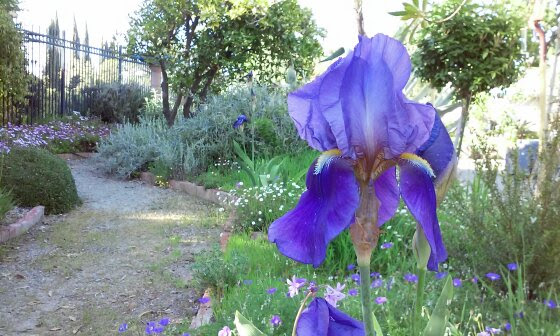
 Bearded Iris rhizomes have arrived!
Bearded Iris rhizomes have arrived!
If you want the impact of large blooming color throughout your garden without a lot of effort, you may find that Bearded Iris was made just for you. Water-wise and long-lived, this perennial is easy to plant and even easier to maintain. It will give you gorgeous color in spring (and fall if you buy re-bloomers). They are the perfect plant to take advantage of our Valley’s “second spring.” Plant immediately & enjoy flowers this coming spring.
Bearded Iris are not only “forgiving” they are such a strong competitor. Bearded iris are often planted en masse or in a row due to the plant’s ability to crowd out weeds. Strong and versatile with high impact colorful appearance, Bearded Iris are ideal both as a border defining plant and as an accent.
Bearded Iris gets its name from the appearance of the flower which has six petals; three upright petals (called standards) and three hanging petals (called falls). A fuzzy line or beard runs down the middle of each fall. Flowers come in many colors including blue, pink, purple, reddish, white, yellow, and bi-colors and have textures from plush velvet to silk — often on the same plant!
You will find that Bearded Iris produces a lot of results for only a small amount of effort and planting and care is easy – just follow these steps:
Choosing a Location
Bearded Iris prefer full sun. However, they are incredibly versatile and will tolerate partial shade. Some of the delicate pink and blue Bearded Iris hold their color better in partial shade. There is a trade-off; however; as shade increases; flowering decreases. The other consideration is good drainage, which is essential for healthy Bearded Iris. Excessive water and dampness are the chief hazards to successful Bearded Iris cultivation. With those location caveats in mind, you should have lots of areas where you can locate this attractive, low-maintenance, high-impact plant to good advantage throughout your garden and landscaping.
Planting
The best time to plant bearded iris is August through October. Early planting will allow them to become well established before winter. That is why they are ideal for our Valley’s “second spring” which starts in mid-August every year.
Iris grow and multiply when growers divide rhizomes, which are sort of like a very thick fleshy root. Bearded Iris produce seed that hybridizers use for developing new varieties.
Planting is easy. Make sure you have a well-prepared bed (see our recipe for good garden soil). Dig a SHALLOW hole about twice the size of the rhizome or clump of rhizomes. Form a mound of soil in the center for the planting base to promote drainage. Make the mound high enough, so the top of the rhizome is slightly above soil level. Spread the roots around the mound, fill with soil, and water. For a mass of color, plant at least three rhizomes (spaced 8 to 10 inches apart) or plant undivided clumps; point each fan of leaves away from the center of the group. Space the clumps 18 inches apart.
Care
As mentioned earlier, Bearded Iris is quite forgiving and require a minimum of maintenance. That is because its rhizomes are nutrient “storage” areas. Like camels, Bearded Iris can tolerate periods of benign neglect and are drought tolerant because each plant has this reserve storage that gets it through. But, rhizomes are both its strength and its weakness. Rhizomes are quite sensitive to moisture, so be sure to keep them well drained and NEVER over water.
Special Tip: Feed monthly from March through September with Maxsea 16-16-16. The last number is potassium, and it is critical to Bearded Iris success. At a minimum, 3 times a year in March, May & September.
Follow us in Social Media